2.2. Internals
In this lecture we look at...
[Section notes PDF 180Kb]
2.2.01. Introduction
- Database internals (base tier)
- RAID technology
- Reliability and performance improvement
- Record and field basics
- Headers to hashing
- Index structures
2.2.01b. Machine architecture (by distance)
- Distance from chip determines minimum latency
- Speed of light is a constant
- Impact of bus frequencies
- IDE (66,100,133 Hz)
- PCI, PCI-X (66,100,133 Hz)
- PCI Express (1Ghz to 12Ghz)
- Impact of bus bandwidths
- PCI (32/64 bit/cycle, 133MB/s)
- PCI Express (x16 8.0GB/s)
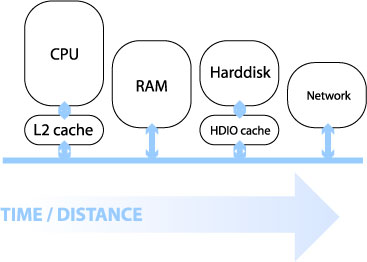
Here's a link from Intel showing a machine architecture with signal bandwidths: Intel diagram
2.2.01c. Machine architecture (by capacity)
- Capacity increased with distance
- Staged architecture as compromise
- Speed, time/distance
- Also cost, heat, usage scale
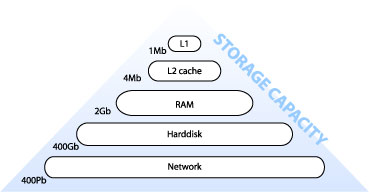
2.2.02. Database internals
- Stored as files of records (of data values)
- Auxiliary data structures/indices
- 1y and 2y storage
- memory hierarchy (pyramid diagram)
- volatility
- Online and offline devices
- Primary file organisation, records on disk
- Heap - unordered
- Sorted - ordered, sequential by sort key
- Hashed - ordered by hash key
- B-trees - more complex
2.2.03. Disk fundamentals
- DBMS task
- linked to backup
- 1y, 2y and 3y
- e.g. DLT tape
- Changing face of current technology
- Impact of inexpensive harddisks
- Flash memory devices (CF, USB)
- Random versus sequential access
- Latency (rotational delay) and
- Bandwidth (data transfer rate)
2.2.04. RAID technology
- Redundant Array of Independent Disks
- Data striping
- Blocks (512 bytes), bits and transparency
- Reliability (1/n)
- Mirroring/shadowing
- Error correction codes/parity
- Performance (n)
- Mirroring (2x read access)
- Multiple parallel access
2.2.05. RAID levels
- 0 No redundant data
- 1 Disk mirrors (performance gain)
- 2 Hamming codes (also detect)
- 3 Single parity disk
- 4 Block level striping
- 5 and parity/data distribution
- 6 Reed-Soloman codes
2.2.06. Records and fields
- DBMS specific, generally
- Records (tuples) comprise fields (attributes)
- File is a sequence of records
- Variable length records
- Variable length fields
- Multi-valued attributes/repeating fields
- Optional fields
- Mixed file of different record types
2.2.07. Fields
- records -> files -> disks
- Fixed length for efficient access
- Networking issues
- Delimit variable length fields (max)
- Explicit record/field lengths
- Separators (,;,:,$,?,%)
- Record headers and footers
- Spanning
- block boundaries and redundancy
2.2.08. Primary organisation
- Bias data manipulation to 1y memory
- Load record to 1y, write back
- Cache theorem
- Data storage investment, rapidity of access
- optimisations based on frequent algorithmic use
- Ordering, ordering field/key field
- Hashing
2.2.09. Indexes/indices
- Auxiliary structures/secondary access path
- Single level indexes (Key, Pointer)
- File of records
- Ordering key field
- Primary, Secondary and Clustering
2.2.09b. Primary index example
- Primary index on simple table
- Ordering key field (primary key) is Integer
- Pointers as addresses
- Sparse, not dense
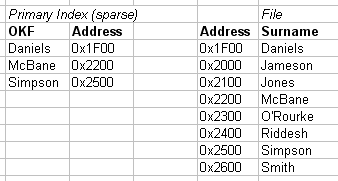
2.2.10. Primary Index file (as pairs list)
- Two fields <K(i),P(i)>
- Ordering key field and pointer to block
- Second example, indexing candidate key Surname
- K(1)="Barnes",P(1) -> block 1
- Barnes record is first/anchor entry in block 1
- K(2)="Smith",P(2) -> block 6
- K(3)="Zeta",P(3) -> block 8
- Dense (K(i) for every record), or Sparse
- Enforce key constraint
2.2.10b. Clustering index example
- Clustering index
- Ordering key field (OKF) is non-key
- Each entry points to multiple records
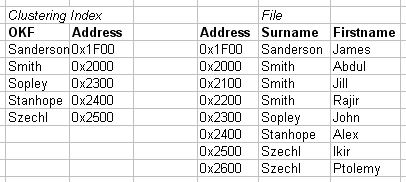
2.2.11. Clustering Index (as pairs list)
- Two fields <K(i),P(i)>
- Ordering non-key field and pointer to block
- Internal structure e.g. linked list of records
- Each block may contain multiple records
- K(1)="Barnes",P(1) -> block 1
- K(2)="Bates",P(2) -> block 2
- K(3)="Zeta",P(3) -> block 3
- K(i) not required to have
- a distinct value for each record
- non-dense, sparse
2.2.11b. Secondary Index example
- Independent of primary ordering
- Can't use block anchors
- Needs to be dense
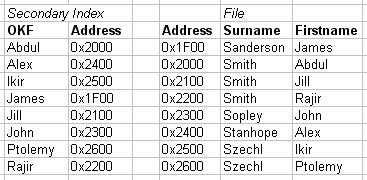
2.2.12. More indices
- Single level index
- ordered index file
- limited by binary search
- Multi level indices
- based on tree data structures (B+/B-trees)
- faster reduction of search space (logfobi)
2.2.13. Indices
- Database architecture
- Intension/extension
- Indexes separated from data file
- Created/disgraded dynamically
- Typically 2y to avoid reordering records on disk
2.2.14. Query optimisation
- Faster query resolution
- improved performance
- lower load
- hardware cost:performance ratio
- Moore's law
- Query process chain
- Query optimisation
2.2.15. Query processing
- Compile-track familiarity
- Scanner/tokeniser - break into tokens
- Parser - semantic understanding, grammar
- Validated - check attribute names
- Query tree
- Execution strategy, heuristic
- Query optimisation
- In (extended relational) canonical algebra form
2.2.16. Query optimisation
- SQL query
- SELECT lname, fname
- FROM employee
- WHERE salary > (
- SELECT MAX(salary)
- FROM employee
- WHERE dno=5
- );
- Worst-case
- Process inner for each outer
- Best-base
- Canonical algrebraic form
2.2.16b. Query optimisation implementation
- Indexing accelerates query resolution
- Closed comparison (intra-tuple)
- all variables/attributes within single tuple
- e.g. x < 100
- Open comparison (inter-tuple)
- variables span multiple tuples
- Essentially a sorting problem
- Internal sorting covered (pre-requisites)
- Need external sort for non-cached lists
2.2.17. Query optimisation
- External sorting
- Stems from large disk (2y), small memory (1y)
- Sort-merge strategy
- Sort runs (small sets of total data file)
- Then merge runs back together
- Used in
- SELECT, to accelerate selection (by index)
- PROJECT, to eliminate duplicates
- JOIN, UNION and INTERSECTION